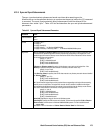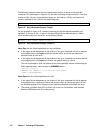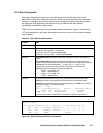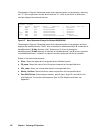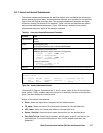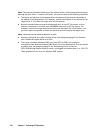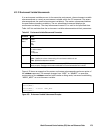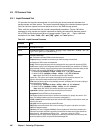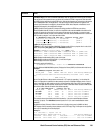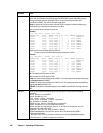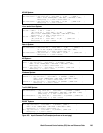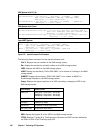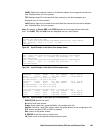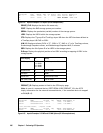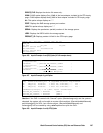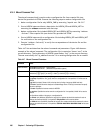
Hitachi Command Control Interface (CCI) User and Reference Guide 281
Parameter Value
-svinf[=PTN] (only Windows systems)
-svinfex[=PTN] (for GPT disk on Windows 2008/2003): Sets the signature and volume layout information
that was saved to the system disk to a raw device file provided via STDIN or arguments. Gets the serial#
and LDEV# for the target device using SCSI Inquiry, and sets the signature and volume layout information
into VOLssss_llll.ini file to the target device. This option will set correctly because the signature and
volume layout information is managed by the serial# and LDEV# without depend on Harddisk#, even if
Harddisk# is changed by the configuration changes.
[=PTN]: Specifies a strings pattern to interpret the strings provided via STDIN as a raw device.
\Device\HarddiskVolume#( number ) is made in a sequential order executed -svinf to Harddisk, and its
number will remain the same as long as the system configuration is not changed. If you want to make
\Device\HarddiskVolume#( number ) more absolutely, then make \Device\HarddiskVolume# in serial# and
LDEV# order by using the “-sort” option as shown below:
D:\HORCM\etc>echo hd5 hd4 hd3 | inqraid -svinf -sort
[VOL61459_
451_5296A763] -> Harddisk3 [OPEN-3 ]
[VOL61459_
452_5296A760] -> Harddisk4 [OPEN-3 ]
[VOL61459_453_5296A761] -> Harddisk5 [OPEN-3 ]
-gplba (only Windows systems)
-gplbaex (for GPT disk on Windows 2008/2003): Displays usable LBA on a physical drive in units of 512
bytes, and specifies [slba] [elba] options for raidvchkset command.
Example:
C:\HORCM\etc>inqraid $Phys -CLI -gplba -sort
Harddisk11 : SLBA = 0x00003f00 ELBA = 0x000620d9 PCNT = 7 [OPEN-3-CVS ]
Harddisk12 : SLBA = 0x00003f00 ELBA = 0x00042ad1 PCNT = 4 [OPEN-3-CVS ]
Harddisk13 : SLBA = 0x0000003f ELBA = 0x000620d9 PCNT = 1 [OPEN-3-CVS ]
SLBA: Displays usable starting LBA in units of 512 bytes.
ELBA: Displays usable ending LBA (ELBA -1) in units of 512 bytes.
PCNT: Displays the number of partitions.
Example for setting of Harddisk11:
C:\HORCM\etc>raidvchkset -d hd11 -vs 16 0x00003f00 0x000620d9
-fv (only Windows 2008/2003/2000 systems): Displays the Volume{GUID} via $Volume with wide format.
Example:
C:\HORCM\etc>inqraid -CLI $Vol -fv
DEVICE_FILE PORT SERIAL LDEV CTG H/M/12 SSID R:Group PRODUCT_ID
Volume{cec25efe-d3b8-11d4-aead-00c00d003b1e}\Vol3\Dsk0 CL2-D 62496
256
- - - - OPEN-3-CVS-CM
-fp or -fl or -pin: Shows a data protection volume with “-CLI” option by appending ‘*’ to the device file
name. If the -fp option is specified, the data protection volume is a Database Validator volume. If the -fl
option is specified, the data protection volume is a Data Retention Utility (Open LDEV Guard on 9900V)
volume. If the -pin option is specified, shows that the volume is PIN track volume because of HDD double
drive failure and/or external connection disks failure especially.
# ls /dev/rdsk/c57t4* | ./inqraid -CLI -fp
DEVICE_FILE PORT SERIAL LDEV CTG H/M/12 SSID R:Group PRODUCT_ID
c57t4d0* CL1-D 62496 32 - s/P/ss 0004 5:01-03 OPEN-3
c57t4d3* CL1-D 62496 35 - s/P/ss 0004 5:01-03 OPEN-3
c57t4d4 CL1-D 62496 36 - s/P/ss 0004 5:01-01 OPEN-3
c57t4d5 CL1-D 62496 37 - s/P/ss 0004 5:01-02 OPEN-3
This example shows that c57t4d0 and c57t4d3 (marked by *) are set to enable Database Validator
checking (-fp option). The raidvchkset command (section 4.12.1) is used to enable/disable volume
protec
tion.
-fg (9900V and later): Shows a LUN on the host view by finding a host group for (9900V and later).
-fw: Displays all of the cascading volume statuses on the STD Inquiry Page. If this option is not specified,
then only four cascading mirrors are displayed.
Example:
# ls /dev/rdsk/* | inqraid -CLI -fw
DEVICE_FILE PORT SERIAL LDEV CTG H../M/.. SSID R:Group PRODUCT_ID
c1t2d10s2 CL2-D 62500 266 - Psss/P/PP----------- 0005 1:01-02 OPEN-3
c1t2d11s2 CL2-D 62500 267 - ssss/P/PP----------- 0005 1:01-02 OPEN-3



